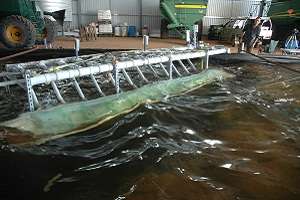Wave power technology crests economical limits

Commercial amounts of energy can be extracted from relatively small ocean waves, according to a Perth company which has developed technology that it believes is the world's most economical in harnessing wave energy.
The Bombora Wavepower Wave Energy Converter system is a V-shaped device that sits on the sea bed near the shore at depths of between five and 15m.
The arms are designed to capture the energy of waves as they move closer to shore and becomes concentrated into a smaller column of water.
Each arm is inclined like a ramp, accentuating the elliptical motion of water particles to extract more energy from both the heave and surge motion of the wave.
The system is made from a simple, low-cost, lightweight flexible membrane with cells below that operate like a giant foot pump to generate power.
As the wave passes over the device it pushes on the membrane, directly transferring the wave energy to pressurised air in the device.
Positive and negative pressures generate air flow into a common manifold system to drive a turbine and generator.
It is anticipated each system will be rated 1.5MWe, a similar scale to the average size of most onshore wind turbines.
Curtin University mechanical engineering lecturer Andrew King assisted Bombora with computer simulations investigating how much power could be generated.
"This required the membrane and wave field to be simulated using High Performance Computing or super-computering like the resources provided by iVEC in the new Pawsey Centre," he says.
"The next stage will be to compare these predictions against the results from tests on scale models of the device.
"This will help to further develop the models to give better predictions of the performance in the next iterations of the design.
Dr King says this system differs from other technology, in that it is situated on the sea-bed directly, and the structure itself is passive.
Bombora Wavepower executive director Shawn Ryan says the company is seeking investment before starting trials in the Swan River 'nursery' in the next six months and moving onto ocean trials.
"The largest energy resource are westerly facing coastal strips around the continents but the Bombora system can operate anywhere, including lower resource locations; wave power is a global resource," Mr Ryan says.
He estimates there are 200 projects worldwide developing various forms of wave energy technology.
He says the system's advantage is its lowest cost of energy production, using relatively low maintenance equipment and low cost materials.
Provided by Science Network WA




















